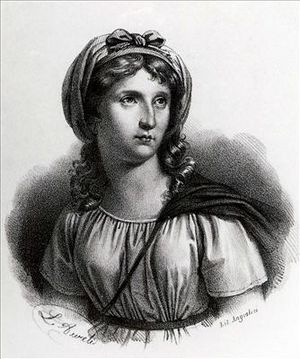Clotilde Tambroni facts for kids
Quick facts for kids
Clotilde Tambroni
|
|
|---|---|
 |
|
| Born | 29 June 1758 |
| Died | 2 June 1817 (aged 58) Bologna
|
| Occupation | Classicist |
| Scientific career | |
| Institutions | University of Bologna |
Clotilde Tambroni (born June 29, 1758 – died June 2, 1817) was an amazing Italian scholar. She was an expert in philology, which is the study of language in historical texts. She was also a linguist, meaning she studied languages themselves. Plus, she was a talented poet.
Clotilde made history at the University of Bologna. In 1793, she became a professor of the Greek language. Later, from 1800 to 1808, she taught both Greek and literature. This was a huge achievement. She got a university job long before most women around the world could even go to college! Besides Italian, she also spoke French, English, and Spanish very well.
Contents
What did Clotilde Tambroni do?
Clotilde Tambroni was recognized for her intelligence early on. In 1790, she was invited to join the Accademia degli Inestricati. This was a group of important scholars. Then, in 1792, she also joined the Accademia degli Arcadi. She used the pen name Doriclea Sicionia there.
Becoming a Professor
Even though she never got a formal university degree, Clotilde was very skilled. On November 23, 1793, she was given a special job. She became the Chair of Greek Language at the University of Bologna. This meant she was in charge of teaching Greek.
In 1797, her friend Georgiana Hare-Naylor had to go back to England. Georgiana trusted Clotilde to look after her children. Clotilde cared for them along with Father Emmanuele Aponte.
Challenges and Return
In 1798, Clotilde faced a challenge. She lost her teaching job. This happened because she refused to promise loyalty to the new government. This government was called the Cisalpine government. It was a new political power in Italy at the time.
After losing her job, she moved to Spain. There, she worked as a researcher with her father, Emanuele Aponte. She was also accepted into the l’Accademia Reale di Madrid. This was another important academic group.
Despite her political views, Clotilde was able to return to her position. In September 1799, she was back at the Accademia degli Inestricati. She was again the Chair of Greek Language and Literature. In 1804, she even received a big pay raise.
Retirement and Legacy
Clotilde retired early from her teaching role. She said it was because of poor health. However, the Greek Chair position was also going to be removed. This was part of new reforms under Napoleon. These changes focused more on teaching science. They gave less importance to literary studies.
Still, Clotilde believed science and literature were connected. In her speech on January 11, 1806, she said so. She noted that Bologna had produced great scientists and humanists.
Adamo Tadolini created a marble statue of Clotilde. The famous artist Canova oversaw this work. Canova was a friend of Clotilde's family. Her work was also honored in a book. Ireneo Affò wrote a long dedication to her in his volume Ragionamento Del Padre.
What did Clotilde Tambroni write?
Clotilde Tambroni wrote many important works. Most of them were poems or essays in Greek and Italian. She often wrote them for special events. For example, she wrote poems for weddings or to celebrate someone's recovery from illness.
Here are some examples of her works:
- Verses for the Wedding of Count Niccolo Fava Ghisilieri and Gaetana Marescotti Berselli (1792)
- Greek-Italian Ode for the Happy Birth of Countess Susanna Jenisson Walworth Spencer (1792)
- Pindaric Ode for the Recovered Health of Cardinal Andrea Gioannetti (1793)
- Greek Sapphic Ode for Count Ferdinando Marescalchi Fava (1794)
- Greek Elegy in Honor of the Famous Printer Giambattista Bodoni (1795)
- Ode in Praise of Field Marshal Count of Clairfait (1796)
Her Letters
Clotilde's letters were also published in several books. These letters give us a look into her life and thoughts. They show her ideas and connections with other scholars.
Some collections of her letters include:
- Unpublished Letters of Clotilde Tambroni (1804)
- Some Letters of the Famous Greek Scholar Clotilde Tambroni (1870)
- Letters of Four Bolognese Gentlewomen (1883)
See also
 In Spanish: Clotilde Tambroni para niños
In Spanish: Clotilde Tambroni para niños

